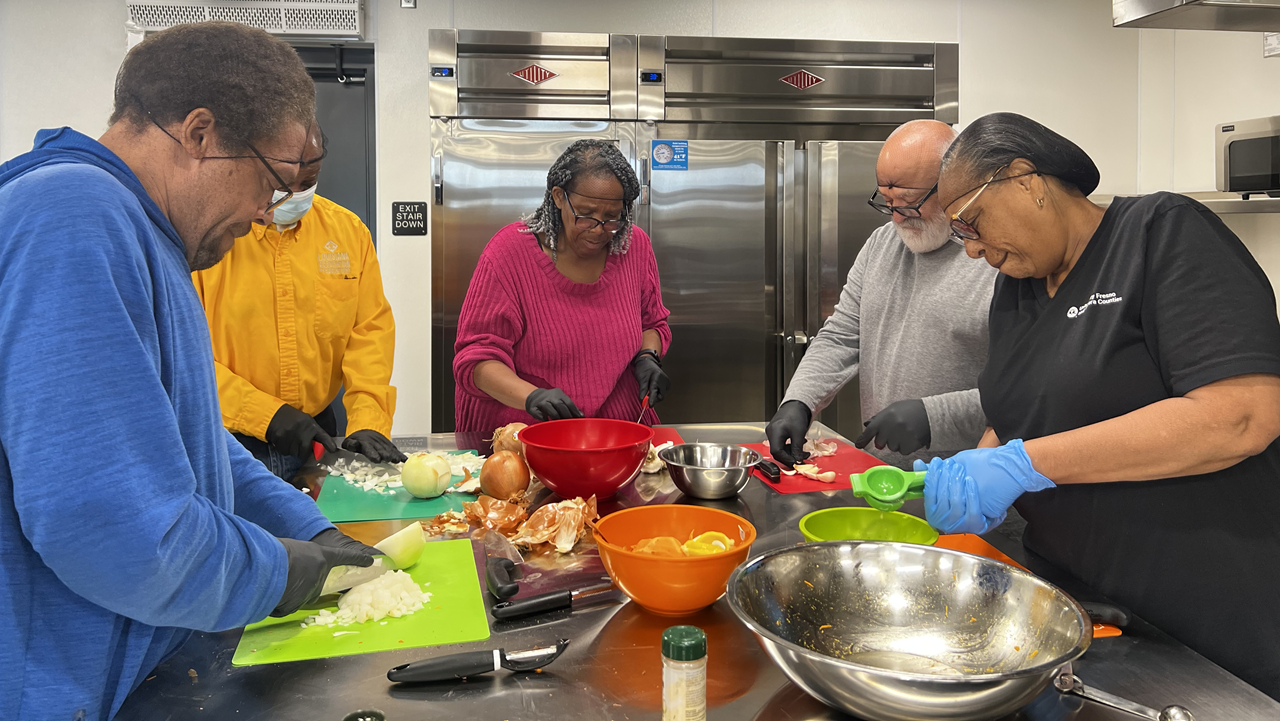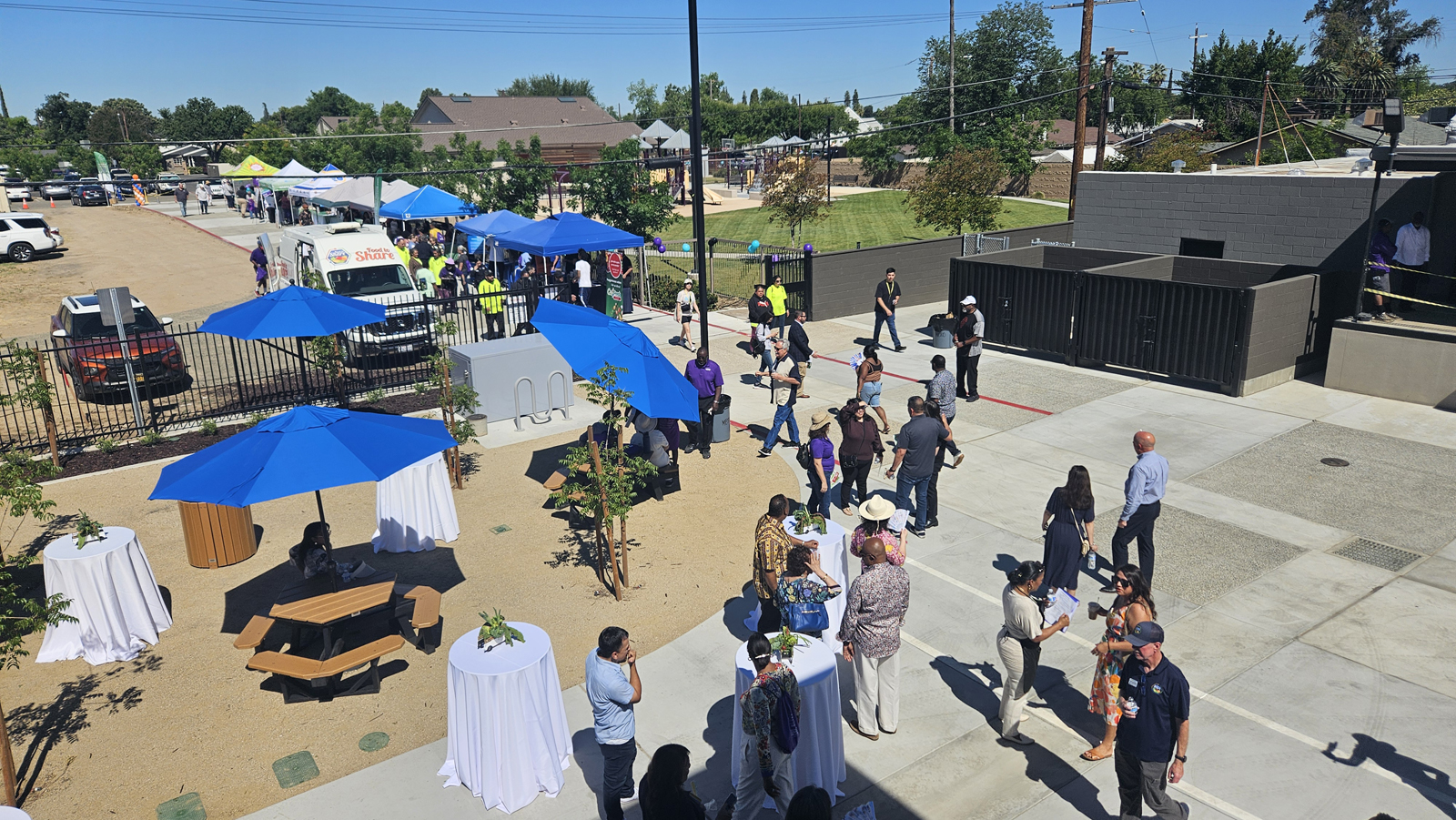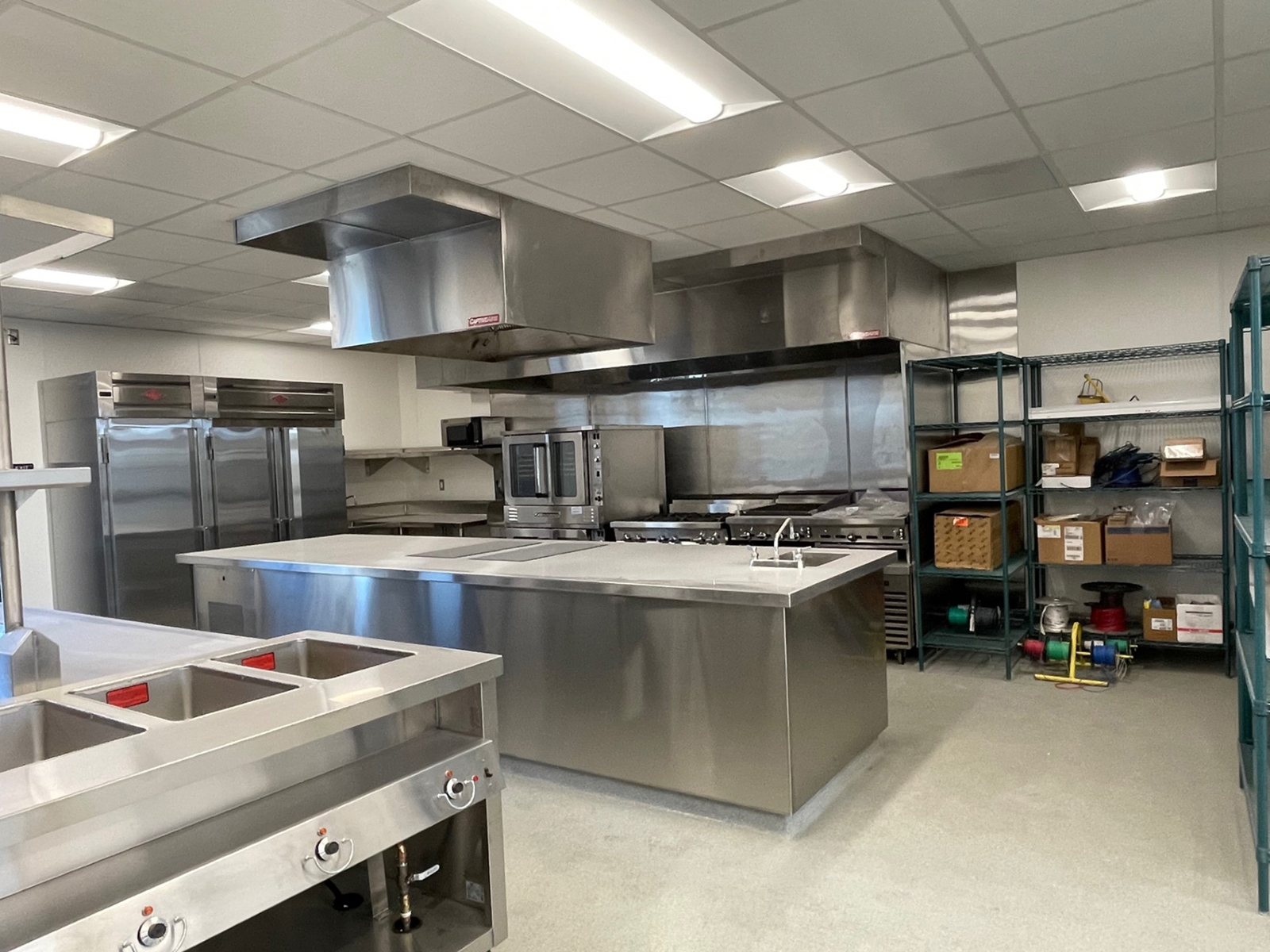
The U.S. food supply is a study in inefficiency, inequity, and contradictions. Americans waste an estimated 30–40% of the country’s food, and although much of it is safe and edible, that food ends up in landfills as 22–24% of municipal solid waste. There it becomes a potent source of methane, a greenhouse gas with four times the warming potential of carbon dioxide. At the same time, one in seven Americans, or 47 million people, including 14 million children, experienced food insecurity in 2023. This marked a 6% increase from 2022, and the highest level recorded since 2014.
Located in California’s Central Valley, which produces 25% of the nation’s food supply, Fresno County is the third hungriest county in the United States. In Fresno, nonprofits like Fresno Metropolitan Ministry (Metro) help feed hungry people by running just-in-time rescue operations that glean surplus food from institutions and retail outlets. It’s an effective strategy, but not a simple one. As Metro’s Executive Director Emogene Nelson describes, “Rescuing food involves more than just picking it up. It requires storage, transportation, timing, and trust. If one link in the chain breaks, the entire system is disrupted. Behind every pound of food saved is a mountain of invisible labor.”
To streamline and expand their food rescue operations, Metro teamed up with St. Rest Baptist Church (SRBC) to redevelop a vacant and environmentally contaminated former meatpacking warehouse into the St. Rest + Food to Share Hub. The Hub, which opened in May 2024, started with a brownfield—land that is frequently vacant, underutilized, or abandoned, and may be contaminated. Metro and SRBC worked with the city of Fresno to leverage multiple federal funding sources that addressed environmental contamination and cleared the way for redevelopment. Their story exemplifies the power of partnerships to build social resilience and contribute to a sense of place, especially in resource-scarce settings.

How a Food Hub Takes Root on a Brownfield
The Hub is located in Southwest Fresno. Known locally as Southwest, it is one of the city’s most underserved, disinvested, and racially diverse neighborhoods. Southwest is also a food desert, with 47 liquor stores and only one grocery store.
The story of the Hub begins with SRBC. Founded in a Southwest living room in 1944, SRBC had long supported congregation members in need, but in 2010, it began hosting monthly community-wide food distribution events. These were all-hands-on-deck affairs: “My wife Bernice would arrange to buy the food, and I’d bring it back to the church in my pickup truck,” remembers Deacon Ron Wiley. While SRBC’s food distributions eventually expanded to include several 20-foot shipping containers, lack of refrigeration meant that distributions always had to take place the same day as food collection. The system worked, but it lacked flexibility.
SRBC saw an opportunity to fundamentally change its food aid work in 2013, when processing giant Hormel Foods failed to find a buyer for its adjacent 5,852square-foot former Farmer John meatpacking warehouse. SRBC approached the company about donating the warehouse and its .4-acre lot. When Hormel agreed, SRBC used technical and financial assistance from EPA Region 9’s Targeted Brownfields Assessment Program to conduct a Phase I environmental site assessment (ESA) in 2013. The ESA identified multiple potential environmental concerns, including an underground storage tank system. SRBC took ownership in 2014, but as Deacon Wiley recalls, “We knew this site was going to need additional work before it could be safe for reuse.”
Around this time, SRBC connected with Metro, a 53-year-old nonprofit with a shared commitment to improving community health and a robust food rescue program called Food to Share. Every day, Metro’s five vans circulate through Fresno’s streets, collecting surplus food from schools, institutions, and grocery stores, and delivering it to distribution locations throughout the city. Like red blood cells carrying oxygen, Metro’s vans help keep Fresno’s network of food banks functioning.
But in the world of food rescue, too much of a good thing is a very real possibility. “It’s possible for us to receive 37,000 pounds of lettuce in a single tractor trailer,” says Nelson, “and our five vans can’t move that much product in a single day.” The level of waste in the American food system means that even the most efficient food rescue systems must continually race against the clock. To enhance its operational resilience and meet growing local needs, Metro needed flexible space to store and refrigerate large quantities of food.
SRBC and Metro had a clear shared need for space with shelving, refrigeration, and room to accommodate both public events and vehicles as large as big rigs. The former Farmer John meatpacking warehouse offered an ideal location, but serious environmental concerns were standing in the way.

A Three-way Partnership Breaks Down Barriers
SRBC and Metro worked methodically to leverage federal funding to address contamination at the former warehouse. From 2014 to 2016, SRBC used EPA Targeted Brownfields Assessments to conduct additional ESAs worth $78,777. These assessments further defined the scope of environmental problems and coincided with the city of Fresno’s 2015 $175,000 EPA brownfields area-wide planning grant, which focused on Southwest. That grant generated a conceptual reuse plan for the former warehouse, which focused on redeveloping the site into a food hub with an adjacent events plaza and green space—all identified as neighborhood priorities in a previous community-driven revitalization plan.
To expand its capacity to support transformational redevelopment projects, SRBC formed the independent nonprofit St. Rest Community Economic Development Corporation, which teamed with the city, Fresno County, and a local community foundation to secure a $600,000 EPA brownfields assessment grant in 2019.
“Organizations like St. Rest were actively involved from the beginning, helping to shape the geographic focus and priorities through a community-driven process,” notes David Densley, projects administrator for Fresno’s planning and development department, whose portfolio includes the city’s brownfields program. “Their deep knowledge of Southwest Fresno and the trust they’ve built as a faith-based organization made them an invaluable partner.”
That 2019 grant supported $32,627 in additional environmental assessment to close data gaps in August 2021. By December, SRBC had a cleanup plan in hand—supported by an additional $10,092 of grant funding—that paved the way to removing asbestos-containing materials and mold in the former warehouse walls and ceiling.
In 2020, the city applied again for EPA brownfields funding, this time securing $800,000 to establish a brownfields revolving loan fund (RLF), which kickstarted cleanup at the former warehouse. From March to June 2022, a $191,000 grant from the RLF supported the removal of one underground storage tank, plus mold and asbestos-containing materials in the warehouse’s walls and ceiling. In total, EPA and the city supplied $1,403,991 in brownfields funding to support environmental assessment and cleanup.
With the cleanup complete, Metro and SRBC initiated a fundraising sprint to raise the $4.3 million necessary to build the Hub in the newly remediated space. “We aggressively braided funding because our goal was always to leave St. Rest with a debt-free asset,” says Metro’s Nelson, even after the global pandemic increased construction costs by 72% to $7.4 million. Construction funding came from over 25 partners, including federal and state grants and private donors ranging from foundations to a local construction company.
Ultimately, the St. Rest + Food to Share Hub is a story about partnership. Metro and SRBC’s strategic coordination with the city and EPA leveraged brownfields funding and technical assistance to address environmental contamination and lower barriers to redevelopment. It’s a recipe that allowed Metro and SRBC to stay focused on meeting fundraising goals and making construction happen to get the project into operation and delivering community benefits.

Generating Triple-Bottom-Line Results
Today, the St. Rest + Food to Share Hub provides triple-bottom-line benefits to Southwest and the larger Fresno community. Home to the redeveloped warehouse and a two-story building with kitchen, office and meeting space, the Hub has allowed SRBC to expand its food distributions from one to three per month, each serving around 200 people.
At each distribution, Metro offers on-site cooking demonstrations using ingredients that are available that day. It also offers six-week long, no-cost nutrition and cooking classes that provide hands-on instruction in healthy food preparation, demand for which has been sufficient to keep classes running almost continuously. “We want to help people learn to incorporate healthy foods into their meals and diets, while shopping affordably for their families,” reports Metro Program Manager Erika Lopez, who organizes the classes. Students report that they use these classes to inform their personal choices and to help educate others. “That is our ultimate goal: creating a community that helps each other grow in education, health, and access to nutritious food,” she says.
As part of its commitment to community health, Metro also invites aspiring food entrepreneurs to attend its classes, and via the Hub, provides access to commercial kitchen space to prepare and wash produce and meet food handling safety requirements. “We want to help local entrepreneurs prepare healthier versions of what they are already selling to the community,” says Nelson.
Finally, the Hub makes significant contributions to reducing greenhouse gas emissions that drive climate change. The St. Rest + Food to Share Hub increased Metro’s food distribution capacity from 3.8 million pounds in 2023 to 4.1 million pounds in 2024, despite operating for only seven months that year. That food supported 1.2 million acts of charitable distribution and keeping it out of landfills prevented the release of an estimated 13.9 million pounds of methane, equivalent to the annual emissions of 40,000 households.
For Nelson, the Hub is critical physical and social infrastructure that is as much about feeding people as it is about providing a sense of belonging. “To see families come to the Hub, whether for food distribution or for a cooking class, and leave nourished, you know it’s not just about food, but also about engaging, connection, and hope. It is a powerful reminder of what’s possible when collaboration, partnership, and grassroots action come together. It’s more than a building; it’s a movement for health, justice, and equity in our community.”
The St. Rest + Food to Share Hub represents a formidable achievement, but the work of Metro, SRBC, and the city of Fresno is far from complete. SRBC remains focused on expanding service offerings at the Hub and developing an adjacent soccer field and festival plaza. Deacon Wiley and his wife Bernice routinely survey food distribution participants. “We ask if they have suggestions for how we can improve our level of service, and we’re really receptive to feedback,” he reports. For example, participants have identified a need for medical care, which SRBC could potentially offer in the Hub’s flexible meeting space on food distribution days. “We’re trying to figure out what the needs are,” says Deacon Wiley. “That’s what the church is there for: to improve the quality of life in the community. That’s what we do.”
Brownfield redevelopment is ultimately about possibility and a commitment to a better future for people and their environment—on community terms. When Metro received its own EPA brownfields community-wide assessment grant in 2023, it began partnering with the city to mutually leverage brownfields resources. The two continue to actively work together, building on the success of the St. Rest + Food to Share Hub to support the redevelopment of other brownfields sites for use as housing, grocery stores, and community gardens. Land reuse is never easy, but few transformative processes are, and partnerships can make the difference. Advises Densley, “Listen early, partner early, and stay committed through complexity. Brownfields truly can make a win-win possible for your community and your partners.”
SARAH SIELOFF is an urban planner and funding strategist at Haley and Aldrich.
LUCY BISHOP is an environmental project planner at Haley and Aldrich.
New, Reduced Membership Dues
A new, reduced dues rate is available for CAOs/ACAOs, along with additional discounts for those in smaller communities, has been implemented. Learn more and be sure to join or renew today!
